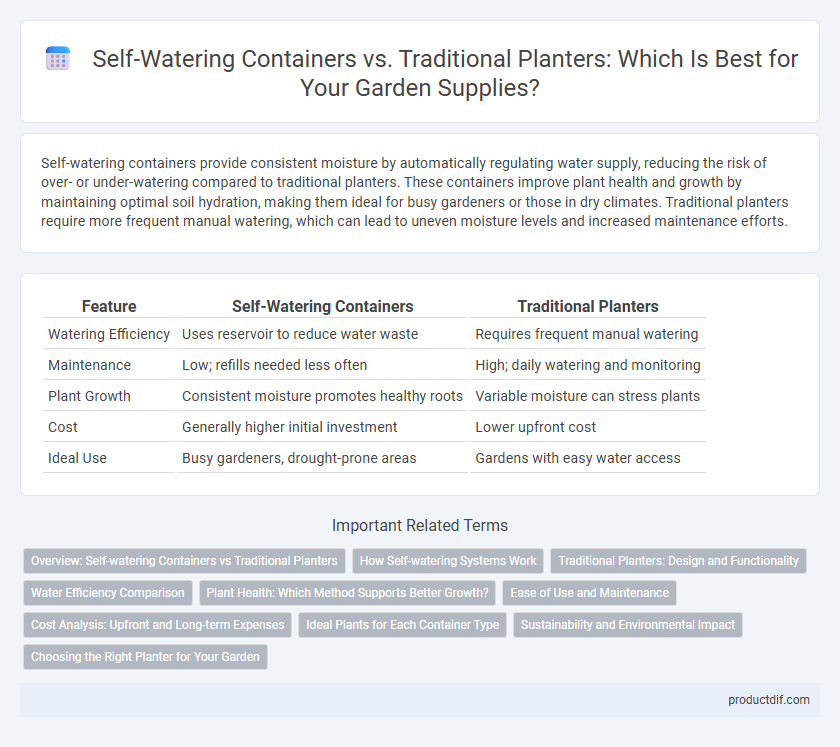Self-watering containers provide consistent moisture by automatically regulating water supply, reducing the risk of over- or under-watering compared to traditional planters. These containers improve plant health and growth by maintaining optimal soil hydration, making them ideal for busy gardeners or those in dry climates. Traditional planters require more frequent manual watering, which can lead to uneven moisture levels and increased maintenance efforts.
Table of Comparison
| Feature | Self-Watering Containers | Traditional Planters |
|---|---|---|
| Watering Efficiency | Uses reservoir to reduce water waste | Requires frequent manual watering |
| Maintenance | Low; refills needed less often | High; daily watering and monitoring |
| Plant Growth | Consistent moisture promotes healthy roots | Variable moisture can stress plants |
| Cost | Generally higher initial investment | Lower upfront cost |
| Ideal Use | Busy gardeners, drought-prone areas | Gardens with easy water access |
Overview: Self-watering Containers vs Traditional Planters
Self-watering containers offer a consistent moisture supply through built-in reservoirs, reducing watering frequency and preventing root rot, making them ideal for busy gardeners or those in dry climates. Traditional planters rely on manual watering and soil retention alone, which can lead to uneven moisture levels and increased risk of over- or under-watering. Choosing between these options depends on plant type, maintenance preferences, and environmental conditions, with self-watering containers enhancing water efficiency and root health.
How Self-watering Systems Work
Self-watering containers use a reservoir at the base that delivers water directly to plant roots through capillary action, reducing evaporation and promoting consistent moisture levels. Unlike traditional planters, these systems minimize the risk of overwatering and underwatering by allowing plants to absorb water as needed. This efficient water management supports healthier root development and reduces watering frequency.
Traditional Planters: Design and Functionality
Traditional planters offer versatile design options that complement various garden aesthetics, available in materials like terracotta, ceramic, metal, and plastic. Their straightforward functionality relies on manual watering and drainage systems, giving gardeners greater control over soil moisture and aeration. These planters support a wide range of plant types and sizes, making them suitable for both indoor and outdoor horticulture.
Water Efficiency Comparison
Self-watering containers reduce water waste by delivering moisture directly to plant roots through a reservoir system, promoting consistent hydration and minimizing evaporation. Traditional planters rely on surface watering, which often results in uneven moisture distribution and higher water loss due to runoff and evaporation. Studies show self-watering systems can improve water efficiency by up to 30% compared to conventional containers.
Plant Health: Which Method Supports Better Growth?
Self-watering containers provide consistent moisture levels, reducing the risk of overwatering or underwatering, which supports stronger root development and healthier plants. Traditional planters require frequent monitoring and manual watering, which can lead to fluctuating soil moisture and stress on plants. Studies show that plants in self-watering containers often exhibit faster growth rates and increased foliage vitality due to optimal hydration conditions.
Ease of Use and Maintenance
Self-watering containers simplify plant care by automatically regulating water levels through built-in reservoirs, reducing the frequency of watering and minimizing risk of over- or under-watering. Traditional planters demand consistent manual watering and monitoring soil moisture, which can be time-consuming and requires more attention to prevent plant stress. Maintenance for self-watering containers often involves occasional reservoir refills and cleaning, whereas traditional planters necessitate regular soil checks and potentially more frequent pest and mold inspections.
Cost Analysis: Upfront and Long-term Expenses
Self-watering containers typically have a higher upfront cost ranging from $20 to $50 compared to traditional planters, which can cost as little as $5 to $20. Long-term expenses for self-watering containers are generally lower due to reduced water consumption and less frequent plant replacement driven by inconsistent watering, resulting in savings on water bills and maintenance. Traditional planters often incur higher ongoing costs due to increased water usage, manual watering labor, and a greater likelihood of plant stress and replacement.
Ideal Plants for Each Container Type
Self-watering containers suit moisture-loving plants such as herbs, leafy greens, and begonias, benefiting from consistent hydration without the risk of overwatering. Traditional planters work best for drought-tolerant species like succulents, cacti, and Mediterranean herbs, which thrive with less frequent watering and better drainage. Choosing the right container based on plant water needs optimizes growth and reduces maintenance.
Sustainability and Environmental Impact
Self-watering containers reduce water waste by delivering moisture directly to plant roots, enhancing water efficiency compared to traditional planters that rely on surface watering. These containers often decrease runoff and evaporation, contributing to sustainable gardening practices by conserving resources and minimizing the need for frequent watering. Traditional planters may lead to overwatering and increased water consumption, making self-watering systems a more eco-friendly solution for environmentally conscious gardeners.
Choosing the Right Planter for Your Garden
Self-watering containers reduce maintenance by providing consistent moisture through an internal reservoir, promoting healthier plant growth and conserving water. Traditional planters offer versatility in soil choices and are often more affordable, but require frequent watering and careful monitoring. Selecting the right planter depends on your garden's watering needs, plant types, and time available for maintenance.
Self-watering containers vs Traditional planters Infographic

 productdif.com
productdif.com